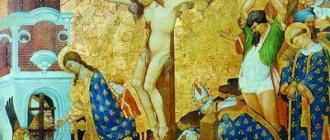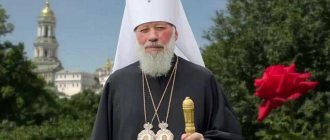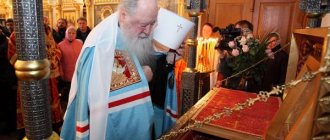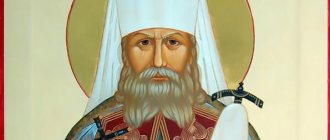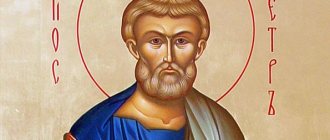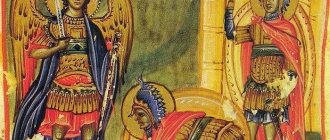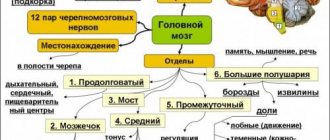| Dionysius of Paris | |
| Was born | III century
|
| Died | about 250[1]
|
| In the face | martyr |
| Day of Remembrance | October 9 |
| Media files on Wikimedia Commons | |
Wikipedia has articles about other people named Dionysius.
Dionysius of Paris
(French Saint Denis, Latin Dionysius) - Christian saint of the 3rd century, first bishop of Paris, martyr.
Life
The oldest surviving biography of the saint is “The Passion of Saints Dionysius, Rustik and Eleutherii” (Latin Passio SS. Dionysii Rustici et Eleutherii), dating back to the year 600 [ source not specified 891 days
]. Saint Dionysius is also mentioned by Gregory of Tours, a historian and saint of the 6th century.
According to legend [ source not specified 891 days
], Dionysius preached Christianity in Rome, and then in the German lands and Spain. He was accompanied by Presbyter Rusticus, Saint Regulus and Deacon Eleutherius. Then Dionysius and his companions began to preach in Gaul. Dionysius, according to legend, became the first bishop of Lutetia (Paris). During the persecution of Christians by pagan authorities, all three preachers were captured and thrown into prison. The next morning the martyrs were beheaded on the top of Montmartre (now within the boundaries of Paris). It was in connection with the execution of three saints that this mountain received its modern name (French Montmartre - mountain of martyrs). Saint Dionysius took his head, walked with it to the temple, and only there did he fall dead. The pious woman Catulla buried the remains of the martyr.
Identification with Dionysius the Areopagite
According to ancient Western tradition, dating back to the opinion of Hildouin, abbot of the monastery of Saint-Denis in the 9th century, Dionysius of Paris is none other than Dionysius the Areopagite, mentioned in the book of the Acts of the Apostles. According to this legend, in obedience to revelation, he left his successor Publius at the Athenian see and came to Rome. And already from Rome, on behalf of the Roman Bishop Clement, he went with Rustik and Eleutherius to Gaul [ source not specified 891 days
].
The question of identifying the two Dionysius - Paris and Athens - was the subject of discussion among churches about apostolic origin [ source not specified 891 days
].
Disagreement on date of death
The encyclopedic dictionary of Brockhaus and Efron indicates that this happened by order of the ruler of Gaul, Sisinius, “according to some news, under Valerian, in 253-260, and according to others, under Maximian Herculius, in 286-292”[2]. The Russian Orthodox Church accepts dating from the second half of the 3rd century[3].
Some sources claim[4] that Eleutherius of Paris “suffered for Christ... during the persecution of Christians by the wicked emperor Domitian.”
Some sources call the date of death of Dionysius the Areopagite[5] and Eleutherius of Paris[6] 96.
Dionysius of Alexandria
Bishop of Alexandria. He is revered among the saints as a holy martyr.
Dionysius of Alexandria was born in 190 in the city of Alexandria, Egypt. In his youth he received a good pagan education and was committed to paganism. After completing his education, he first served as a rhetorician and taught young men eloquence, in the spirit of the pagan science he had studied. But his clear and bright mind could not help but see the gross errors and superstitions of the pagan faith in which he was born and raised, and the shortcomings of the pagan philosophy in whose principles he was raised.
His inquisitive spirit, hungry and thirsty for truth, could not find satisfaction in pagan knowledge and beliefs; his heart felt the futility and deceit of paganism and, not yet knowing the true God, was already striving for Him. And so Dionysius, wanting to know the truth, gets acquainted with various human teachings and beliefs and compares them with each other. This true path of impartial study of human teachings led Dionysius, with his ardent desire to find true faith, to the knowledge of the One true God and to the conscious acceptance of the faith of Christ. Saint Dionysius later said about himself that he “turned to Christ through free research, impartially testing human teachings.”
At that time, in Alexandria, famous for its pagan schools and scientists, along with the multifaceted development of the learning of the then pagan world, Christian enlightenment also achieved a significant degree of prosperity. The famous leaders of the Christian, so-called “catechetical” school that arose there, by the strength of their talents, combined theological and philosophical learning in their instructions and were well acquainted with pagan learning and its representatives. Under the influence of these Christian teachers, the best of the pagans often came to the knowledge of the true faith of Christ and abandoned their pagan wickedness.
Dionysius, already familiar with many Christian works, entered into close communication with the Alexandrian Christian teachers, led by Hieracles and especially the famous Origen. Many pagans flocked to Origen, as a remarkable scientist, to listen to philosophy and mathematics, and Origen took advantage of this and successfully worked for the glory of the name of Christ, using his works and information in order to convert these listeners to communion with Christ.
Saint Dionysius soon became a zealous disciple of Origen and, with all the fervor of an inquisitive spirit, began to study the truths of Christian teaching, the superiority of which over paganism he immediately appreciated. With great zeal and love he read the apostolic epistles, especially the epistles of the holy Apostle Paul, which made a deep impression on him and a decisive revolution in all his beliefs and views, the consequence of which was his completely conscious conversion to Christianity. Having finally become convinced of the truth of Christianity, he did not hesitate to accept, partly under the influence of Origen, holy baptism, and entered the Catechetical School, becoming its true adornment.
From that time on, Saint Dionysius began to delve even more zealously into the deep truths of Christian teaching, protecting its purity from the heretical false teachers and unrighteousness that entered it. He was especially close to his teacher Origen, having reverent gratitude and heartfelt affection for him, and did not stop his alliance with him even when Origen was subsequently forced to leave Alexandria and even when he was in prison. The saint's remarkable successes in learning the truths of Christianity and his pious life attracted the attention of the teacher of the Alexandrian school, Hierakles, to him.
After a short time, Dionysius was elevated to the rank of presbyter. After Origen was removed from Alexandria, Hieracles replaced him in the Alexandrian Catechetical School as head. When Ierakles was elevated to the rank of Bishop of Alexandria, Dionysius became the head of the catechetical school; after the death of Hieracles, he was his successor at the See of Alexandria.
From the time Dionysius entered the See of Alexandria, his whole life became a continuous series of selfless exploits against various enemies of the Church, external and especially internal. At that time, the Church of Christ suffered a lot from the external persecution of the pagan authorities and was even more torn apart by various discords, heretical false teachings and schisms that threatened to disrupt church unity and the internal peace of the Church. In such difficult times, the saint was destined by God Himself to serve as a strong support for the believers. Thanks to him, indeed, the peace in the Church, despite all the dangers and turmoil, remained unshaken. And the holy, strictly pious life of the archpastor, his selfless love for his flock, meekness, sincerity and humility inspired universal respect for him, even among his enemies and heretics.
The entire life of Dionysius of Alexandria was devoted to zealous and tireless service to the Church of God. With especially ardent zeal he cared about the conversion of unbelievers; he treated those who were in error with heartfelt, fatherly meekness and was concerned about the reconciliation of those who were divided. In sorrow he revealed sublime courage, in faith - unshakable constancy, throughout his entire life, amazing, deep humility - while the entire Christian world was amazed at his learning and virtues.
Having inherited from Origen a love for all kinds of knowledge, Saint Dionysius found it possible to harmonize it with Christian doctrine and, as before, carefully read and studied the works of the best pagans and various heretics, who in his time worried the Church of God with their false teachings. Protecting the purity of Christian church teaching from heretical false teachings and differences of opinion, he rejected them, however, not before, out of personal conviction, he recognized their inconsistency, and then he armed himself with strength and courage against the wicked heretics.
For all his intelligence and learning, meek and humble, Saint Dionysius, even in the pastoral department, was distinguished by a spirit of meekness and moderation. At that difficult time for Christians, during the cruel persecution of the wicked king of Rome Decius, some bishops - not out of fear of persecution and torment, but in order not to leave without guidance, edification and consolation the verbal sheep of the flock of Christ entrusted to the care of their care - withdrew from their cities to safer places, and from there they ruled their flocks. This is what Saint Dionysius did at this difficult time, by Divine inspiration, not out of fear of death for the name of Christ, but out of necessity and for the good of the Church of Alexandria, so as not to leave the flock without a shepherd.
Prefect Sabinus sent a spy to find Dionysius. The saint remained at home for four days, but the spy, being sure that he had fled, looked for him in the fields, roads and rivers, and it did not occur to him to enter the archpastor’s house. After this, obeying inner inspiration, Saint Dionysius fled with some of his brethren, but was captured and sent to Taposiris for torture. However, God protected His faithful saint. Quite unexpectedly, he was miraculously rescued from the hands of soldiers by a crowd of Christian villagers.
Staying in a hidden place, Saint Dionysius continued to govern the Alexandrian flock, sending letters to it through trusted elders. At that painful time, the Church endured terrible suffering and sorrow from the ferocious pagans. Unable to endure torture and torment, many of the believers renounced Christ. Afterwards, with deep repentance and heartfelt sorrow, they again turned to the bishop, humbly begging to again accept them into the bosom of the Church of Christ. The meek and humble Dionysius condescendingly accepted them into the number of children of the Christian Church, imposing on them certain prohibitions and penances, and thereby saving them from complete despair.
After the death of the wicked Decius, during the short reign of Emperor Gall, the persecution of Christians ceased, and peace was established in the Church of Christ. This peace of the Church was all the more desirable because it allowed Saint Dionysius to turn with pastoral care to calm the unrest caused by the Arsinoean bishop Nepos, who preached a heresy called chiliasm. The Holy Father not only wrote an essay against Nepos in the spirit of love, but in the same spirit he held conciliar meetings with the defenders of this heresy and achieved that they all turned to Church unity. Dionysius also took an active part in the dispute that was raised in the Church about the baptism of heretics, being most concerned about calming the unrest caused in the Church by this dispute, which he managed to achieve with his admonitions.
At the same time, Dionysius of Alexandria zealously fought against the evil and dangerous heresy of Sabellius that arose in the Alexandrian Church. Trying to counteract his destructive heretical false teaching, which created considerable temptation in the Church of Christ and drew even some bishops into its net, the saint convened councils, wrote district letters against Sabellius, trying to dispel the self-will of the proud mind, which did not recognize the trinity of Persons in God: God the Father, the Son of God and the Holy Spirit.
But Saint Dionysius’s concerns for the inner peace and good of the Church were suddenly stopped by the persecution of the new Roman Emperor Valerian. At the very beginning of this cruel persecution, the great shepherd of Alexandria was captured, despite his serious illness, and together with the presbyter Maximus and the deacon Faustus, Eusebius and Herimon, he was presented to the prefect Emilian. The torturers in every possible way encouraged Dionysius to renounce Christ and sacrifice to idols, for others would follow him. But Dionysius fearlessly refused this.
Then Emilian, having forbidden the saint any communication with Christians, especially any appeal to them with a word of edification and preaching of the Gospel teaching, exiled him to the provincial village of Tsefro, which lay among the wild Libyan desert. But even there, contrary to the prohibition, the saint continued to teach the word of God and, like a valiant martyr of Christ, refused to fulfill the command of his tormentors. The pagans beat him repeatedly with stones for this. Despite this, he had the consolation to convert many pagans to the holy faith of Christ in the desert.
The success of Dionysius' preaching irritated Emilian even more, and he sent the holy bishop to the town of Collufo, located in an even more remote and wild part of the Libyan desert. But even from here I had the consolation of communicating with the friends of Christ and with my flock, and not only with my own, but also with other churches. Saint Dionysius always acted this way before, clearly realizing that, as the primate of one of the main churches, influencing other churches and Christian communities with his voice, he must take care not only of his flock, but also of the entire Church, especially in order to resist every attempt to disturb the universal peace of the Church.
Dionysius spent three years in this cruel and cruel captivity. Upon the accession of Gallienus, he was returned from captivity, to the great consolation of his flock and the entire Church of Christ. However, even in Alexandria this valiant sufferer of Christ was awaited not by peace and prosperity, but by bloody confusion and suffering. After the sorrows of internecine war there followed a severe famine, and after the famine a pestilence that raged with terrible cruelty. With true fatherly love, Dionysius cared for the unfortunate, no matter who they were - pagans or believers.
In addition to these sorrows and his own serious bodily ailments, a new sorrow was added for Saint Dionysius: this unshakable pillar of Orthodoxy and warrior against unbelief and heresies was suspected of unrighteousness, and was forced, not so much for his own protection, but for the pacification of the Church, to write a letter in which he outlined his Orthodox teaching about the Three Persons of the Holy Trinity. The truth triumphed, and the high respect of the entire Church for him and for all his strictly Orthodox views, which protected the purity of faith in this troubled time for the Church, remained unshaken.
Finally, the physical strength of the confessor of Christ had completely weakened due to old age, sorrows and excessive work, although his spirit was strong. When the Church began to worry about the heretical teaching of Paul of Samosata, a council of holy fathers and teachers of the Church was convened in Antioch, to which Saint Dionysius was one of the first to be invited, for everyone expected from him a decisive voice and pacification of the Church. But the great shepherd of the Alexandrian Church, depressed by old age, felt completely unable to bear the burden of such a long journey and was forced to refuse the invitation. However, instead of directly delivering his word, he sent a lengthy letter to the fathers of the council, in which he outlined his Orthodox view of the teachings of Paul of Samosata.
A few days later, on October 18, 265, Dionysius of Alexandria peacefully surrendered his spirit to God. The Church mourned much over this grave loss, for it lost in the person of the saint a great teacher and father of the Church and an unshakable pillar of Orthodoxy.
Memory of Dionysius of Alexandria
Memory of Dionysius of Alexandria
Memory is accomplished
in the Orthodox Church - October 18 in the Catholic Church - November 17
16.10.2019
Reverence
Saint Dionysius with his head in his hands.
Late Gothic sculpture The veneration of the saint began in Gaul almost immediately after his death. The Life of Saint Genevieve reports that a church was built over the tomb of Saint Dionysius already in the 5th century. Later, the Abbey of Saint-Denis grew on this site.
Saint Dionysius is considered one of the patrons of Paris; in Catholicism he is one of the Fourteen Holy Helpers.
It was officially included in the General Roman Calendar in 1568 by Pope Pius V [ source not specified 891 days
].
October 9, as a feast day in memory of St. Dionysius, has been revered in the Western Church since the end of the 8th century [ source not specified 891 days
].
Until the 8th century, Saint Dionysius was not revered in the East [ source not specified 891 days
].
In the 9th century, the future Patriarch of Constantinople Methodius compiled the life of Saint Dionysius in Greek, supplementing it with the legend of the martyrdom of Saint Dionysius in Paris. Saint Demetrius of Rostov compiled the lives of the saints in Russian and used both Greek and Latin sources. His “Lives” for October 3 contains a description of the activities of Saint Dionysius in Athens and his exploits in the West [ source not specified 891 days
].
The memory of the saint in Orthodoxy is October 3 (or, in other Churches, October 3 according to the new style) [ source not specified 891 days
].
Orthodox veneration of Dionysius in Paris
October 19, 1997, for the first time in many years, in the chapel of the Basilica of Saint-Denis, in which the relics of the three holy martyrs rest [ source not specified 891 days
], an Orthodox prayer service was performed. Representatives of two Orthodox jurisdictions took part in it. The Romanian Patriarchate was represented by Archpriest Marc-Antony Costa-de-Beauregard, rector of the Church of St. Herman of Paris and Venerable Clodoald in Louvciennes, and Priest François Faure, rector of the Church of St. Cassian the Roman in Aix-en-Provence. The Moscow Patriarchate was represented by Archpriest Gerard de Lagarde, rector of the Church of the Icon of the Most Holy Theotokos “Joy of All Who Sorrow” and Venerable Genevieve of Paris in Paris, Deacon Joseph Fouilleul, cleric of the same church, Deacon Nikolai Nikishin, cleric of the Three Hierarchs Compound of the Moscow Patriarchate in Paris. Since then, Orthodox prayer services in front of the relics of Saint Dionysius and his companions have been held regularly.
St. Dionysius
Also on topic:
CHRISTIANITY
(c. 200–268), Pope (259–268), probably Greek by birth. At the end of the persecutions of Decius and Valerian, he reorganized the structure of the Roman diocese, as a result of which the cemetery churches became rural parishes and the boundaries of the bishoprics in the vicinity of Rome were clearly defined. Pope Dionysius condemned the heresy of Sabellius, who taught that the three Persons of the Trinity are only external forms of manifestation or aspects of the one God. His relationship with Dionysius of Alexandria is discussed below. The saint's feast day is December 30.
Dionysius the Small
(c. 475–550), Scythian monk who lived in Rome from the late 5th century. until about mid. 6th century The nickname Small (Exiguus) may have expressed his humble self-abasement in front of other great bearers of the same name. Dionysius was fluent in both Latin and Greek, which allowed him to play an important role in the contacts between Eastern and Western traditions. He compiled a compilation of cathedral canons: 165 of them were translated by him from a similar collection that already existed by that time in Greek, 50 were borrowed from the Apostolic Decrees
; in addition, this compilation included a number of decrees adopted by the councils of the Roman and African churches. This collection existed in three author's editions, the last of which is apparently lost. In addition to this collection, Dionysius compiled a selection of papal decretals consisting of 41 articles. Both collections served as the basis for canon law to guide the Western Church for many centuries. Dionysius also wrote a number of treatises on calculating the time of Easter, which greatly contributed to the settlement of the ancient dispute. At the same time, he synchronized Roman and Christian history, establishing that Christ was born 754 years after the founding of Rome. His calculations laid the foundation for the system of counting time “from the Nativity of Christ,” which we still use today.
